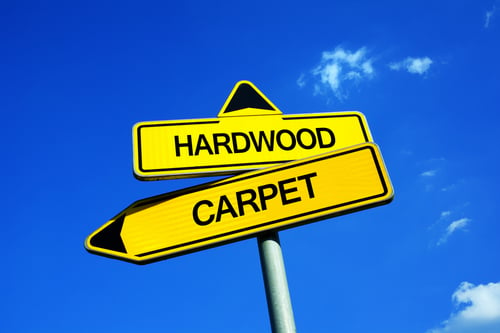Flooring is crucial to attracting and keeping renters. Not only can quality and clean flooring make your rental property look new, but it can also up your home value and rental value. Beautiful flooring is also a way to attract potential prospects. There are plenty of flooring options to choose from, and all will have different price points and durability. Consider all of your options as well as the pros and cons for each with this 2020 flooring guide.
Flooring Options for Your Anne Arundel County Rental Home

Carpet – Carpet can be a fantastic choice for bedrooms and living rooms, but avoid using them in bathrooms and kitchens where they’re more likely to become damaged. There are plenty of pros and cons to keep in mind when considering carpet.
Pros:
- Carpet is easy and affordable to install
- Quick and easy to replace when needed
- Inexpensive flooring option
- Comes in many different designs, textures, and colors
Cons:
- Generally, carpet is one of the shortest lasting flooring options. Typically, cheaper carpets will need to be re-stretched or replaced every 1 – 2 years, while the higher-end products might survive for 5-7 years. Durability also depends on use and care by the tenant. Carpets are easily stained and torn and require more frequent replacement that some of the other options.
- Due to wear and tear, they will undoubtedly require deep cleaning between tenants, if not replaced. Even though it may be less expensive upfront, it can become costly in the long run.
Luxury Vinyl Tile (LVT) – Luxury Vinyl Tile, or LVT, is a tile made to look like real wood flooring. Unlike wood flooring, it is a durable option that provides a polished look with a significant impact.
Pros:
- Looks like wood, but is much more durable and longer-lasting
- More affordable than wood flooring
- You can DIY the installation if you’re particularly handy, cutting down costs significantly
Cons:
- Synthetic texture may not look or feel just like wood. For some, that makes it look cheap
- It can never be sanded or refinished
- You should change it every five years or so to keep up with current styles. It can’t be manipulated or stained to fit the latest trend like real wood can.
Tile – Modern tile flooring comes in an endless variety of colors, patterns, and styles. Production techniques are advanced enough to create tiles that closely mimic stone, wood, and other natural materials, along with different sizes and mosaic styles to truly achieve a customized look.
Tile Pros:
- Tile flooring is a longer-lasting flooring option
- Durable
- Easy to clean and maintain
Tile Cons:
- Expensive to install
- If a tenant is hard on it, it can crack and start looking worn
- It has to periodically be re-grouted and sealed, which can add to costs if you’re unable to do-it-yourself. Unless you’re skilled in tile work, we recommend skipping the DIY!
Vinyl – Vinyl is similar to luxury vinyl flooring and also provides a wood look or other unique designs; however, it’s much thinner than wood or LVT.
Pros:
- Moisture resistant
- Variety of décor choices and styles
- Low maintenance — easy to clean and install on your own
- Low budget options
- Includes a commercial-grade wear layer
Cons:
- A lot thinner than luxury vinyl tile which makes it more susceptible to wear and tear
- Difficult to remove when glued
- Easily punctured
- Not biodegradable.
Laminate – Laminate flooring is a hybrid between particle wood boards and a transparent protective layer. Laminate is a popular choice in rental homes but should be avoided for areas with high humidity.
Pros:
- Scratch-resistant
- Easy to clean and suitable for homes with pets or children
- Inexpensive and can be installed inexpensively.
Cons:
- Moisture can damage the flooring which means it is not suitable for laundry rooms, bathrooms and some basements
- Chips and damages easier than other floor types.
Hardwood – Hardwood floors are certainly appealing to buyers and renters when looking at homes. It generally comes in three different types; strip, plank, and parquet. Strip flooring is 1 ½ – 2 ¼ inches wide according to The Spruce, whereas the other two forms are wider. Hardwood floors may come unfinished, which may be appealing to a home buyer as they can finish to their taste. As a landlord, you would either need to purchase a property with finished wood floors or get them finished before putting on the rental market.
Pros:
- Easy to maintain
- Many styles and colors to choose from
- Add high rental value to your property and home value for an eventual sale
- It can be vacuumed and swept to keep clean.
Cons:
- Very pricey compared to other listed options
- Scratched and scuffed floors need complete refinishing (can’t just replace a part of it like with laminated and LVT)
- They can be noisier than other floor types
When choosing a flooring option, keep costs and pros/cons at the top of mind. Each type of flooring is useful in different circumstances. Also, consider the fact that a singular flooring type does not have to be used throughout the entire home — mixing and matching carpet, tile or wood is a common way to add variety. Most will use tile in bathrooms, carpet or wood in bedrooms and living rooms, and LTV or vinyl in kitchens.
Are you a landlord searching for more tips for your Anne Arundel County rental property. Contact an expert property manager at Bay Property Management Group Anne Arundel County for all of your property management needs!
